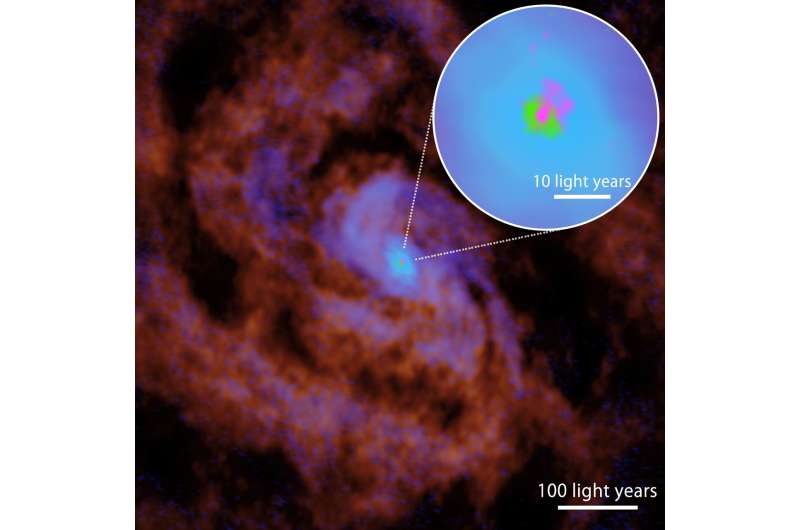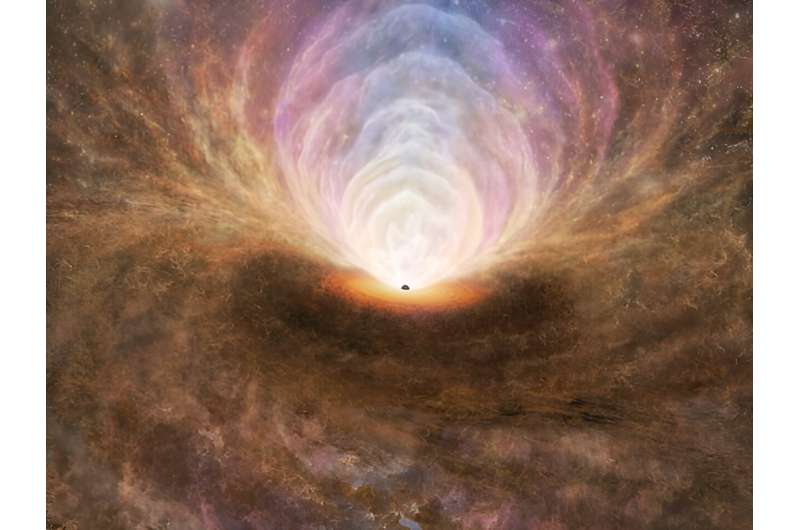This article has been reviewed according to Science X's editorial process and policies. Editors have highlighted the following attributes while ensuring the content's credibility:
fact-checked
peer-reviewed publication
proofread
Astronomers observe supermassive black hole feeding and feedback on sub-parsec scales

An international research team led by Takuma Izumi, an assistant professor at the National Astronomical Observatory of Japan, has achieved a milestone by observing the nearby active galactic nucleus of the Circinus Galaxy, with an extremely high resolution (approximately 1 light-year) by using the Atacama Large Millimeter/submillimeter Array (ALMA).
These observation results, titled "Supermassive black hole feeding and feedback observed on sub-parsec scales," are published in Science.
This marks the world's first quantitative measurement of gas flows and their structures in the immediate vicinity, down to the scale of a few light-years, of a supermassive black hole in all phase gases including plasma, atomic, and molecular. As a result, the team has clearly captured the accretion flow heading towards the supermassive black hole and has revealed that this accretion flow is generated by a physical mechanism known as "gravitational instability."
Furthermore, the team also found that a significant portion of this accretion flow is not utilized for the growth of the black hole. Instead, most of the gas is expelled from the vicinity of the black hole as atomic or molecular outflows, and returns back to the gas disk to again participate into an accretion flow towards the black hole: this gas recycling process is akin to a water fountain. These findings represent a crucial advancement towards a comprehensive understanding of the growth mechanisms of supermassive black holes.
At the centers of many massive galaxies, there exist "supermassive black holes" with masses exceeding a million times that of the sun. How are these supermassive black holes formed? One of the crucial growth mechanisms proposed by previous research is "gas accretion" onto the black hole. This refers to the process in which gas in the host galaxy somehow falls toward the central black hole.
The gas that gathers very close to supermassive black holes is accelerated at high speeds due to the gravity of the black hole. As a consequence of intense friction between gas particles, this gas heats up to temperatures reaching several million degrees and emits brilliant light. This phenomenon is known as an active galactic nucleus (AGN), and its brightness can at times surpass the combined light of all the stars in the galaxy. Interestingly, a portion of the gas that falls towards the black hole (accretion flow) is thought to be blown away by the immense energy of this active galactic nucleus, leading to outflows.

Both theoretical and observational studies have provided detailed insights into gas accretion mechanisms from the 100,000 light-year scale of the galaxies down to a scale of a few hundred light-years at the center. However, the gas accretion within a much smaller region, especially within a few dozen light-years from the galactic center, has remained unclear due to its extremely limited spatial scale.
For instance, to quantitatively comprehend the growth of black holes, it is necessary to measure the accretion flow rate (how much gas is flowing in) and to determine the amounts and types of gases (plasma, atomic gas, molecular gas) that are expelled as outflows at that small scale. Unfortunately, observational understanding in this regard has not progressed significantly until now.
In this study, the research team initially succeeded in capturing, for the first time, the accretion flow heading towards the supermassive black hole within the high-density gas disk extending over several light-years from the galactic center. Identifying this accretion flow had long been a challenging task due to the small scale of the region and the complex motions of gas near the galactic center.
However, in this instance, the research team pinpointed the location where the foreground molecular gas was absorbing the light from the background brightly shining active galactic nucleus. This identification was made possible through high-resolution observations with ALMA. Detailed analysis revealed that this absorbing material is moving in the direction away from us. Since the absorbing material always exists between the active galactic nucleus and us, this indicates that the team has successfully captured the accretion flow towards the active galactic nucleus.
Furthermore, the research team has also elucidated the physical mechanism responsible for inducing this gas accretion. The observed gas disk itself exhibited a gravitational force so substantial that it could not be sustained by the pressure calculated from the motion of the gas disk.
When this situation arises, the gas disk collapses under its own weight, forming complex structures and becoming incapable of maintaining stable motion at the galactic center. As a result, the gas rapidly falls towards the central black hole. Now ALMA has clearly revealed this physical phenomenon known as "gravitational instability" at the heart of the galaxy.
In addition, this study has significantly advanced the quantitative understanding of gas flows around the active galactic nucleus. From the density of the observed gas and the velocity of the accretion flow, the accretion rate at which gas is supplied to the black hole can be calculated. Surprisingly, this rate was found to be 30 times greater than what is actually required to sustain the activity of this active galactic nucleus.
In other words, the majority of the accretion flow at the 1-light-year scale around the galactic center was not contributing to the growth of the black hole. So, where did this surplus gas go? This mystery has also been unraveled in this study—high-sensitivity observations of all phase gases (medium-density molecular, atomic, and plasma; corresponding to red, blue, and pink regions in first image above) with ALMA detected outflows from the active galactic nucleus.
Through quantitative analysis, it was revealed that the majority of the gas that flowed towards the black hole was expelled as atomic or molecular outflows. However, due to their slow velocities, they couldn't escape from the gravitational potential of the black hole and eventually returned to the gas disk. There, they were recycled back into an accretion flow towards the black hole, akin to a fountain, thus completing a fascinating gas recycling process at the galactic center (second image).
Regarding the achievements of this study, Izumi states, "Detecting accretion flows and outflows in a region just a few light-years around the actively growing supermassive black hole, particularly in a multiphase gas, and even deciphering the accretion mechanism itself, are indeed monumental achievements in the history of supermassive black hole research."
Looking ahead to the future, he continues, "To comprehensively understand the growth of supermassive black holes in cosmic history, we need to investigate various types of supermassive black holes that are located farther away from us. This requires high-resolution and high-sensitivity observations, and we have high expectations for the further use of ALMA, as well as for upcoming large radio interferometers in the next generation."
More information: Takuma Izumi et al, Supermassive black hole feeding and feedback observed on sub-parsec scales, Science (2023). DOI: 10.1126/science.adf0569. www.science.org/doi/10.1126/science.adf0569
Journal information: Science
Provided by ALMA





















